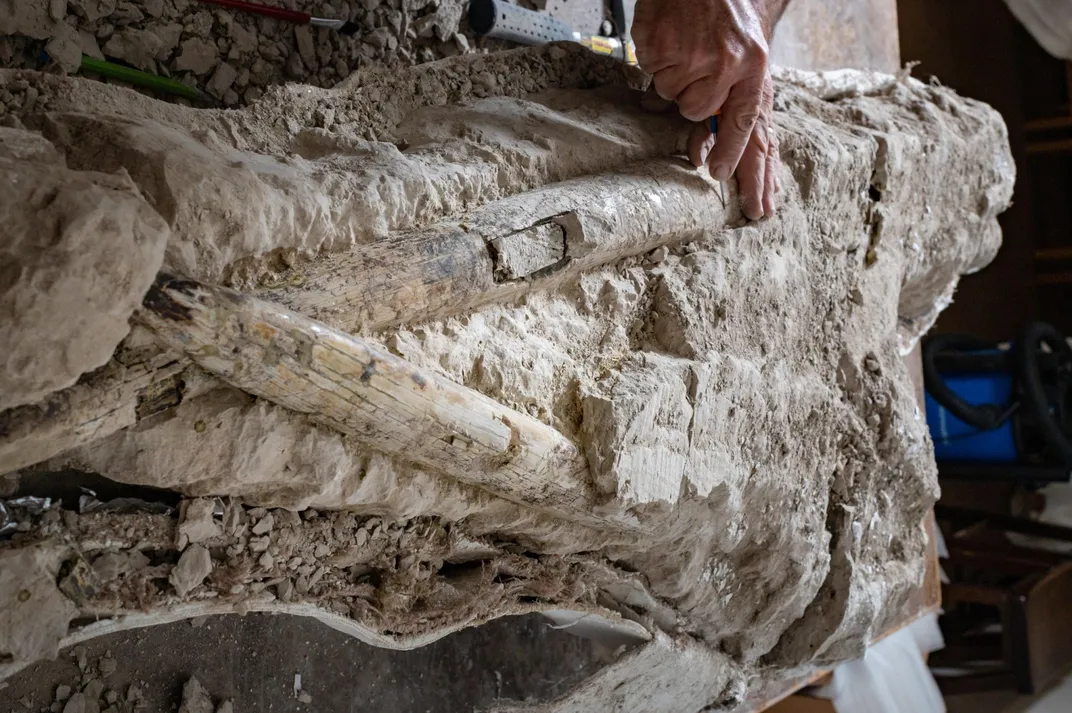Park Ranger Stumbles Upon Treasure Trove of Several-Million-Year-Old Fossils in Northern California
Paleontologists found hundreds of Miocene fossils, including an 8-million-year-old mastodon, at an undisclosed location in the Sierra Nevada foothills
:focal(716x168:717x169)/https://tf-cmsv2-smithsonianmag-media.s3.amazonaws.com/filer/2a/74/2a7430d6-f030-4985-b98f-f1fa3cf01d73/fossils-lead-art-cst.jpeg)
In the foothills of the Sierra Nevada Mountains in California, paleontologists have uncovered a collection of fossils, including an eight-million-year-old mastodon skull with both tusks intact, a rhino skeleton, a giant tortoise, 600 petrified trees, and many more specimens. Dating back to the Miocene epoch, the site is considered one of the most significant fossil discoveries in California history, reports Andrew Chamings for SFGate.
"Few other fossil discoveries like this exist in California," says California State University paleontologist Russell Shapiro, to Ashley Gebb for Chico State Today.
Park ranger and naturalist Greg Francek from the East Bay Municipal Utility District (EBMUD) first stumbled upon a petrified forest while on patrol in the Mokelumne River Watershed, located in the Sierra Nevada, reports the Chico State Today.
"I looked around the area further, and I found a second tree," Francek says in a statement. "And then a third and so on. After finding dozens of trees, I realized that what I was looking at was the remains of a petrified forest."
After three weeks of surveying and uncovering more fossilized pieces of the forest, Francek found what appeared to be vertebrate fossils, Chico State Today reports. From there, EBMUD reached out to paleontologists and geologists from California State University, Chico, to take a closer look.

Shapiro's team excavated the site and uncovered the tip of a pearly, white bone. As the team etched away at the rock encasing the bone, teeth, a skull, and two tusks belonging to the elephant-like, eight-million-year-old mastodon emerged, reports Tia Ghose for Live Science. The last time mastodon remains were found in California was in 1947 during pipeline construction, EBMUD explains in a statement.
In the past year since the initial discovery, Shapiro and his team have found hundreds of animal fossils from varying species within the site of the petrified forest remains. Among the finds were a horse, a tapir, the remains of an ancestral 400-pound salmon with sharp teeth, an extinct species of camel that was as tall as a giraffe, and a gomphothere, which is an ancient elephant with four tusks, SFGate reports.
With each fossil find, the team unraveled the region's geologic history and suspect that the remains ended up in the watershed when floods and volcano debris flows carried them there, reports Live Science. The team also hypothesized that the enormous, fossilized mammals roamed the area's oak and flood plains.
"The bones paint a clearer picture of life 10 million years ago when animals evolved from living in forests to grassland as the landscape changed," Shapiro says in a statement.
The excavation team plans to continue excavating at the undisclosed site location and studying the fossils for further insight into the area's history. Those interested in seeing the mastodon skull can view it on display starting September 1 at the California State University, Chico's Gateway Science Museum, reports Chico State Today.
/https://tf-cmsv2-smithsonianmag-media.s3.amazonaws.com/accounts/headshot/gamillo007710829-005_0.png)
/https://tf-cmsv2-smithsonianmag-media.s3.amazonaws.com/accounts/headshot/gamillo007710829-005_0.png)